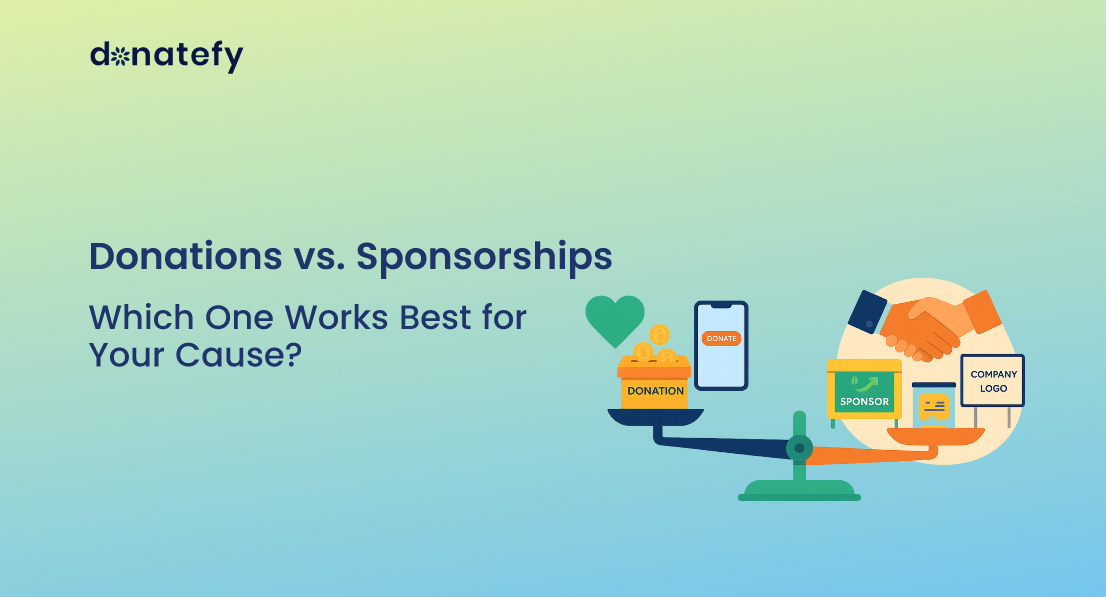For nonprofits, schools, and community organizations, the question of how to fundraise effectively is never simple. Among the many revenue streams available, donations and sponsorships stand out as two of the most common and often misunderstood options. While they both generate funding, they differ significantly in motivation, sustainability, and strategic value. Understanding the nuances between the two is essential for leaders aiming to design resilient fundraising strategies. Let’s dig deeper.
Donations: Mission-Driven Giving
At their core, donations are acts of altruism. They come from individuals (or sometimes institutions) who believe in your mission and want to contribute to its success often without expecting tangible returns.
- Psychology of donors: Donors are motivated by empathy, shared values, and the desire for impact. Studies consistently show that emotional connection and storytelling drive donor decisions more than rational incentives.
- Nature of support: Donations especially recurring gifts can provide predictable, unrestricted revenue, enabling organizations to cover operating costs, invest in growth, or respond to emergencies.
- Strategic value: A strong donor base builds financial resilience. Over time, even small individual gifts compound into a sustainable revenue stream.
However, donations require relationship-building. Retaining donors means consistent engagement, transparency in impact reporting, and nurturing a sense of belonging. Without it, donor fatigue or attrition is inevitable.
Sponsorships: Partnerships with Purpose
Unlike donations, sponsorships are transactional by design. Companies or brands contribute financial or in-kind support in exchange for visibility, access to your audience, or alignment with your cause.
- Psychology of sponsors: Businesses are motivated by ROI whether that’s brand exposure, CSR (Corporate Social Responsibility) goals, or deeper community engagement.
- Nature of support: Sponsorships often yield larger one-off contributions compared to individual donations, making them ideal for events, campaigns, or capital projects.
- Strategic value: A well-structured sponsorship can amplify credibility and visibility for your organization by associating your mission with established brands.
But sponsorships come with obligations. Unlike donors, sponsors expect deliverables like branding opportunities, media coverage, measurable outcomes. Failing to meet these expectations can damage the relationship and your reputation.
Key Considerations: Which Path to Prioritize?
When choosing between donations and sponsorships, consider these factors:
- Sustainability vs. Scale
- Donations provide long-term, renewable revenue.
- Sponsorships offer scale often larger lump sums but usually short-term.
- Donations provide long-term, renewable revenue.
- Mission Alignment
- Donations stem from shared values and emotional commitment.
- Sponsorships depend on aligning your mission with corporate objectives.
- Donations stem from shared values and emotional commitment.
- Control & Flexibility
- Donation funds are often unrestricted, giving you freedom to allocate where needed most.
- Sponsorships may come with conditions, limiting how you can use funds.
- Donation funds are often unrestricted, giving you freedom to allocate where needed most.
- Relationship Dynamics
- Donor relationships are built on storytelling and trust.
- Sponsorships require negotiation, contractual agreements, and performance metrics.
- Donor relationships are built on storytelling and trust.
The Balanced Approach: Why You Need Both
The smartest organizations don’t choose between donations and sponsorships, they integrate both.
- Donations anchor your mission with grassroots support and financial stability.
- Sponsorships provide capital boosts and broaden your reach through brand alliances.
Think of donations as the steady heartbeat of your nonprofit, while sponsorships are the adrenaline shots that accelerate specific initiatives. A hybrid strategy diversifies risk, strengthens resilience, and ensures you’re not overly reliant on one funding source.
Final Thoughts
There’s no universal answer to whether donations or sponsorships “work best.” The real question is: How can your organization structure both to complement each other?
By cultivating donor loyalty and strategically engaging sponsors, you can build a diversified funding ecosystem one that sustains your mission in the long term while fueling ambitious campaigns in the short term.






